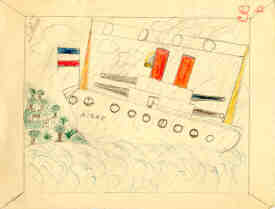 |
1.
Recto: [2-8-937, C. Alonso, 3rd].
Verso:Este dibujo lo he visto yo y representa -- Aqui
he dibujado mi evacuación de Sn Sebastián a Francia, 14 años,
Carlos Alonso, De San Sebastián, Colonia infantil de Bayona, Francia
[This drawing is of what I have seen and it represents -- Here I have drawn
my evacuation from San Sebastián to France, age 14, Carlos Alonso,
from San Sebastián, Children's Camp of Bayonne, France]. |
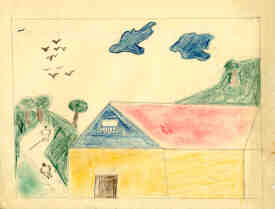 |
2.
Verso:Este dibujo representa en un [a sid crossed
out] monte cogiendo grillos. Carlos Alonso (niño), [San S crossed
out], 14 años, San Sebastián, Colonia infantil de Bayona
(Francia) [This drawing shows catching crickets on a mountain. Carlos
Alonso (boy), age 14, San Sebastián, Children's Camp of Bayonne
(France)]. |
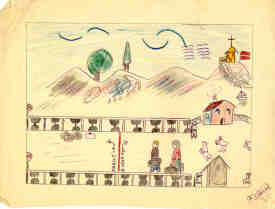 |
3.
Recto: [France/Spain, F. Olavera].
Verso:Evacuacion de Irún (Guipuzcoa) durante
la guerra, Fernando Olavera (niño), De 13 años, Colonia de
infantil de Bayona (Francia) [Evacuation from Irún (Guipuzcoa)
during the war, Fernando Olavera (boy), Of age 13, Children's Camp of Bayonne
(France)]. |
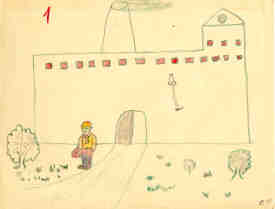 |
4.
Verso:Yo he querido dibujar cuando iba a llevar la
comida a mi padre, Jesús Vergara, tantos años 10, De Fitero
(Navarra), Colonia infantil de Bayona, Francia [I wanted to draw when
I was going to take food to my father, Jesús Vergara, a great 10
years, From Fitero (Navarre), Children's Camp of Bayonne, France]. |
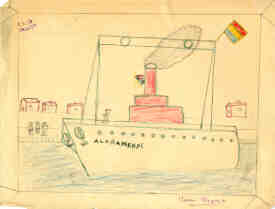 |
5.
Recto: [8-3-38, Bayona, Aloñamendi, Jesús
Vergara].
Verso:Aqui he dibujado mi evacuación de San
Sebastian a Francia, años 10, Jesús Vergara (niño),
De Fitero (Nabarra), Colonia infantil de Bayona (Francia) [Here I have
drawn my evacuation from San Sebastian to France, age 10, Jesús
Vergara (boy), From Fitero (Navarre), Children's Camp of Bayonne (France)]. |
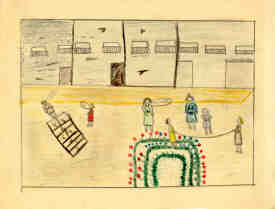 |
6.
Recto: ["Out" "Yes" "Higher"].
Verso:Este cuadro significa la vida nuestra en esta
colonia. Pilar Luna = niña, 14 años, Colonia infantil de
Bayona, Francia [This picture represents our lives in this colony.
Pilar Luna = girl, age 14, Children's Camp of Bayonne, France]. |
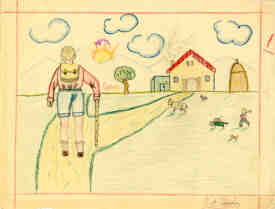 |
7.
Recto: [J.A. Sánchez].
Verso:Este dibujo que yo he hecho nos biene a decir
la tranquilidad que teniamos durante el tiempo de paz, este dibujo es una
escursión que hice al monte. José Antonio Sánchez,
Edad 11 años (niño), De Sestao (Vizcaya), Colonia infantil
de Bayona (Francia) [This drawing that I have done tells us of the
tranquility that we had during times of peace, this drawing is an excursion
that I took to the mountains. José Antonio Sánchez, Age 11
years (boy), From Sestao (Vizcaya), Children's Camp of Bayonne (France)]. |
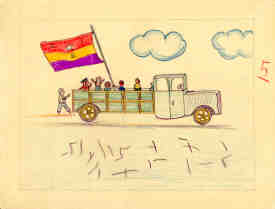 |
8.
Verso:Esta escena da la sensación de como ayuda
al Gobierno Español, el S.R.I Frances. En este auto van niños
Españoles con camaradas Franceses pidiendo dinero para el Gobierno
Español. José Antonio Sánchez, De Sestao (Vizcaya),
Edad 11 años, Colonia infantil de Bayonne (Francia) [This scene
gives the idea of how the French S.R.I. helped the Spanish Government.
In this automobile Spanish children go with their French companions to
ask for money for the Spanish Government. José Antonio Sánchez,
From Sestao (Vizcaya), Age 11 years, Children's Camp of Bayonne (France)]. |
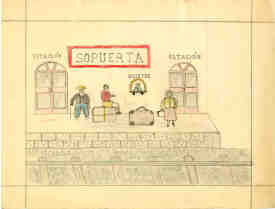 |
9.
Recto: [Sopuerta Station, Tickets].
Verso:Este dibujo que yo presento da ha entender la
evacuación de Bilbao, yo estoy esperando al tren en la estación
de Sopuerta. José Antonio Sánchez, Edad 11 años, De
Sestao (Vizcaya), Colonia infantil de Bayonne (Francia) [This drawing
that I make gives an account of the evacuation from Bilbao, I am waiting
for the train in the Sopuerta station. José Antonio Sánchez,
Age 11 years, From Sestao (Vizcaya), Children's Camp of Bayonne (France)]. |
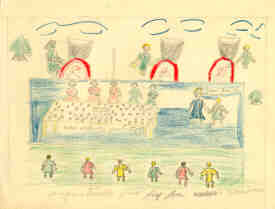 |
10.
Recto: [Mom has the key, they are peeling potatos, asking
the cook what there is to eat].
Verso:Esta escena he dibujado yo cuando iba a la cocina
y le decía a mi madre que tendría la llave y veo como echaban
patatas en la caldosa y veía como helaban. Anita Ayestarán,
años 12, De Behobia (Gipuzcoa), Colonia infantil de Bayona [This
scene I have drawn myself when I went to the kitchen and asked my mother
if I could have the key and I saw how they threw potatoes in the broth
and I saw how they boiled. Anita Ayestarán, age 12, From Behobia
(Gipuzcoa), Children's Camp of Bayonne]. |
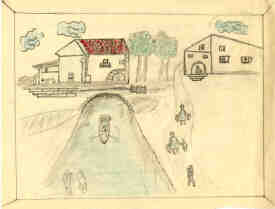 |
11.
Verso:Esta escena representa como evacuemos nosotros
de Endarlaza hacia la parte de France. José Ayestarán, De
13 años (niño), De Irun. Colonia infantil de Bayona (Francia)
[This scene represents how we evacuated ourselves from Endarlaza towards
the French side. José Ayestarán, Of age 13 (boy), From Irun.
Children's Camp of Bayonne (France)]. |
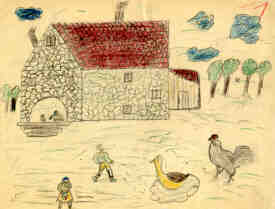 |
12.
Verso:Esta escena representa cuando yo vivía
en Endarlaza antes de estallar la guerra. José Ayestarán
(niño), De 13 años, De Irun (Guipuzcoa), Colonia infantil
de Bayona (Francia) [This scene shows when I lived in Endarlaza before
the war broke out. José Ayestaràn (boy), Age 13 years, From
Irun (Guipuzcoa), Children's Camp of Bayonne (France)]. |
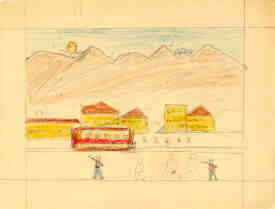 |
13.
Verso:Este dibujo representa: 1 Un pueblo cercano
a Tolosa (Izascun) ardiendo por los cañonazos de los fascistas 2
La gente corre a los trenes nada mas sentir los primeros cañonazos
que iban contra el pueblo vecino. Antonio Gonzalez -- niño, Natural
de Asturias, 13 años, Colonia infantil de Bayona (Francia), La evacuacion
que echa en Tolosa (Guipuzcoa) [This drawing represents: 1) A town
near Tolosa (Izascun) burning from the fascist cannon-shots; 2) The people
run to the trains just from feeling the first cannon-shots that were fired
at the neighboring town. Antonio Gonzalez -- boy, native of Asturias, age
13, Children's Camp of Bayonne (France), The evacuation that was done in
Tolosa (Guipuzcoa)]. |
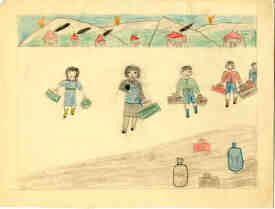 |
14.
Verso:Este dibujo es la evacuacion de mi madre mi
hermano y yo cuando ibamos para santander. Y los cañones lanzaban
obuses que incendiaban el monte Arraiz. Luisa Rodriguez (niña),
11 años, De Bilbao, Colonia infantil de Bayona (Francia) [This
drawing is the evacuation of my mother my brother and I when we left for
Santander. And the cannons shot shells that burned the Arraiz mountain.
Luisa Rodriguez (girl), age 11, From Bilbao, Children's Camp of Bayonne
(France)]. |
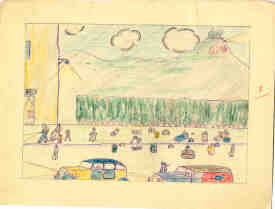 |
15.
Verso:Este dibujo quiere decir de que forma evacue
yo de Irún. Emilio Canyión, De Irún (Guipuzcua), años
14 niño, Colonia infantil de Bayona, Francia [This drawing shows
how I evacuated Irún. Emilio Canyión, From Irún (Guipuzcua),
age 14 boy, Children's Camp of Bayonne, France]. |
 |
16.
Verso:He dibujado aqui uno de los momentos de nuestra
evacuación de Durango. El hecho sucedió en 1 de Abril de
1936. El 30 de Marzo fué el bombardeo asesino que efectuó
la aviación alemana contra la población civil de Durango.
Salimos con dirección a una aldea, a 3 km. de mi pueblo, mi madre,
mi abuela y yo. Luis Altuna, De Durango, Edad 12 años, Colonia Infantil
de Bayona (Francia) [I have drawn here one of the moments from our
evacuation of Durango. It happenned on April 1, 1936. March 30th was the
murderess bombing done by the German airforce against the civilian population
of Durango. We left in the direction of a village, 3 km. from my town,
my mother, my grandmother and I. Luis Altuna, From Durango, Age 12 years,
Children's Camp of Bayonne (France)]. |
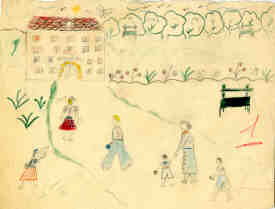 |
17.
Recto: [School].
Verso:En este dibujo yo lo practico asi queriendo
dar la idea de cuando tenia 8 años iba a la escuela con mi hermanita
antes de la guerra. Míren Gárate (años), 13 años,
De S. Sebastián, Colonia infantil de Bayona (Francia) [This
drawing I make in this way wanting to give the idea that when I was eight
years old I went to school with my little sister before the war. Míren
Gárate (years) age 13, From S. Sebastián, Children's Camp
of Bayonne (France)]. |
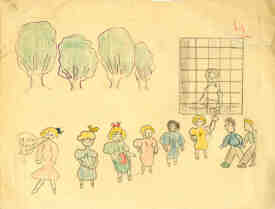 |
18.
Recto: ["They are already giving out the bread"].
Verso:Rosario Diego, años 14, Natural de Bilbao,
Este dibujo representa cuando toca el pan y todos estamos en la cola, a
un lao los chicos y a otro las chicas. Colonia infantil de Bayona (Francia)
[Rosario Diego, age 14, Native of Bilbao, This drawing represents when
the bread comes and we are all in line, boys on one side and girls on the
other. Children's Camp of Bayonne (France)]. |
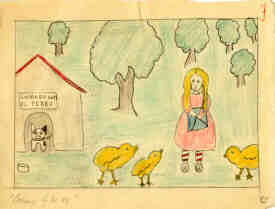 |
19.
Recto: [Beware of the dog].
Verso:Esta escena representa una niña dando
de comer a sus pollitos. Mª Begoña Ullibarri (Niña),
años 13, Natural de Bilbao, Colonia infantil de Bayona (Francia)
[This scene shows a little girl feeding baby chicks. María Begoña
Ullibarri (Girl), age 13, Native of Bilbao, Children's Camp of Bayonne
(France)]. |
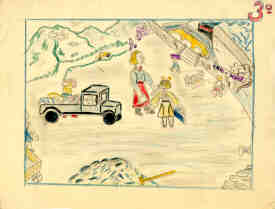 |
20.
Verso:En este dibujo, se vé cuando evacuamos
Bilbao, y estabamos esperando en el muelle para que nos mandaran entrar
al barco y venir a Francia. Inés Millán Romero (niña),
13 años, de Bilbao, Colonia infantil de Bayona, Francia [In
this drawing, one can see when we evacuated Bilbao, and we were waiting
at the pier for them to tell us to board a boat and go to France. Inés
Millán Romero (girl), age 13, from Bilbao, Children's Camp of Bayonne,
France]. |
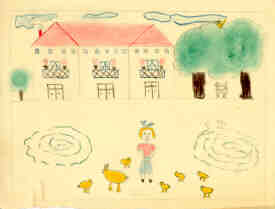 |
21.
Verso:Este dibujo representa una niña dando
de comer a los pollos. Manolita Moreno, De 13 años, De San Sebastian,
Colonia Infantil de Bayona (Francia) [This drawing shows a little girl
feeding chickens. Manolita Moreno, Age 13 years, From San Sebastian, Children's
Camp of Bayonne (France)]. |
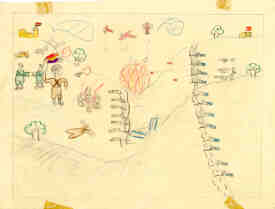 |
22.
Verso:Esta escena es lo que yo me imagino en el frente.
Mª Pilar Landa (niña), 11 años, Colonia infantil de
Bayona, Francia [This scene is how I imagine the front. María
Pilar Landa (girl), age 11, Children's Camp of Bayonne, France]. |
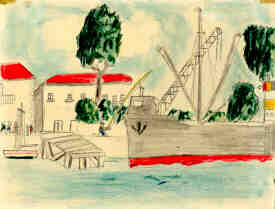 |
23.
Verso:Esta escena significa el muelle de Bayona y
nosotros saliendo de paseo. Elias Ganalda, 12 años, De Pamplona
[This scene shows the Bayonne pier and us going out on a walk. Elias Ganalda,
age 12, From Pamplona]. |
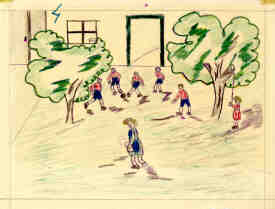 |
24.
Verso:Este dibujo he hecho para representar nuestra
vida en la Colonia, ahí vemos unos niños jugando al balón,
otro que soy yo tocando la campana por ya es hora de comer y una encargada
llevando el caldero de la comida. Angeles Arnáíz (niña),
14 años, Colonia Infantil de Bayona (Francia) [This drawing
I have done to show our life in the Camp, here we see some children playing
ball, another which is me ringing the bell because it is lunchtime and
another undertaking carrying the pot with the food. Angeles Arnáíz
(girl), age 14, Children's Camp of Bayonne (France)]. |